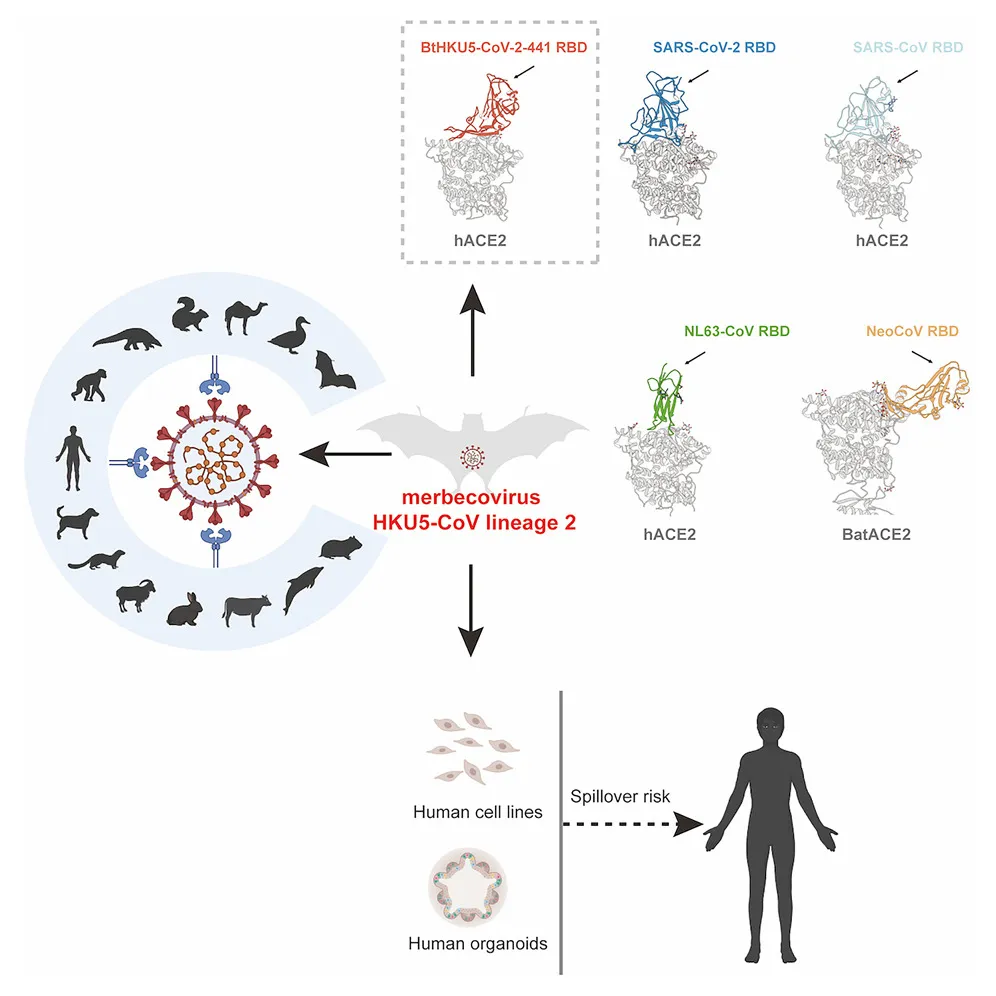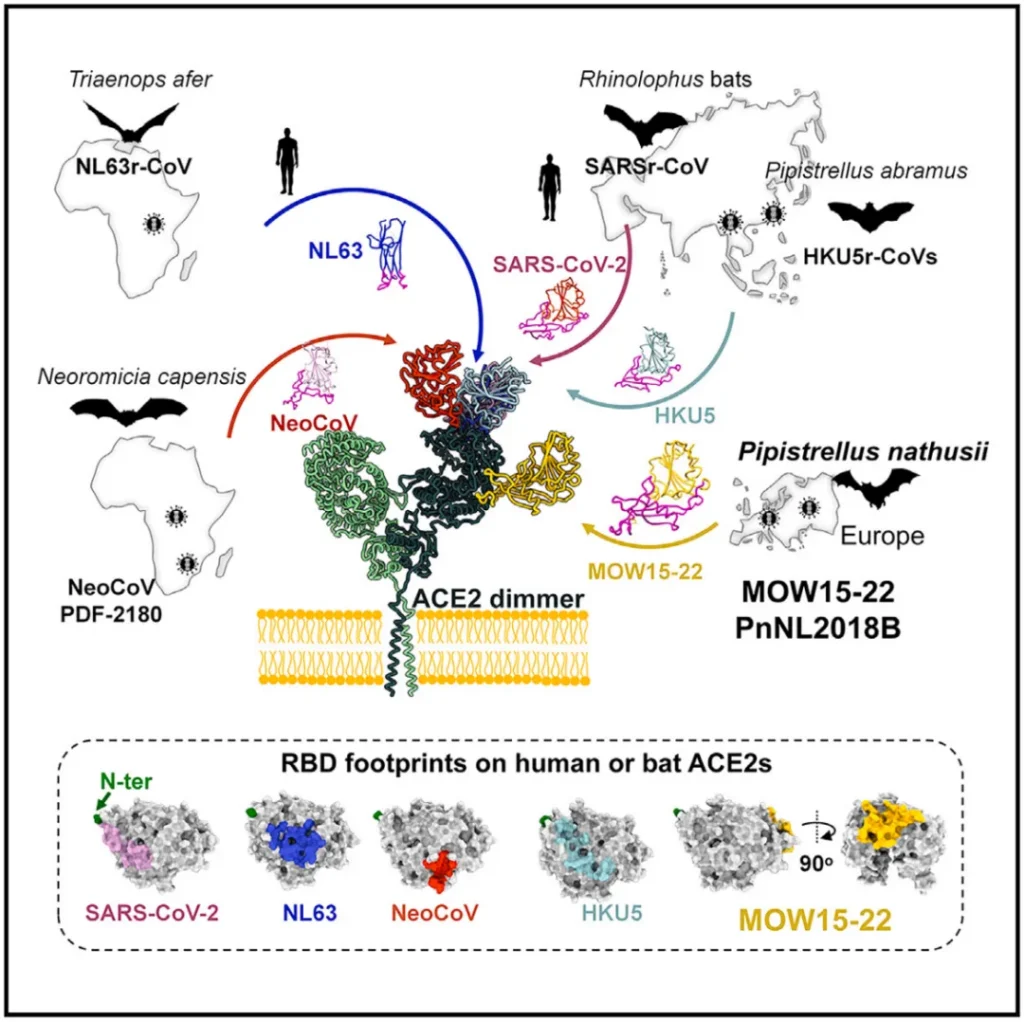New Virus Discovered
Zhengli Shi’s team published another cell. They discovered a novel bat coronavirus that invades using human ACE2 infection.
Coronaviruses of the subgenus Merbecovirus found in European bats include four genetically distinct viral species – Middle East Respiratory Syndrome-associated coronavirus (MERSr-CoV), flying fox coronavirus HKU4 (HKU4-CoV), amblypygid bat coronavirus HKU5 (HKU5-CoV), and hedgehog coronavirus-1 (HH-CoV-1). However, the potential risk of spillover of these coronaviruses to humans remains to be investigated.
On February 18, 2025, Zhengli Shi, Wei Peng and Peng Zhou from Guangzhou Laboratory, Huan Yan from Wuhan University and Libiao Zhang from Institute of Zoology, Guangdong Academy of Sciences published a research paper in Cell, a leading international academic journal, entitled: Bat-infecting merbecovirus HKU5-CoV lineage 2 can use human ACE2 as a cell entry receptor.
The study identifies a unique HKU5 coronavirus from bats, HKU5-CoV-2, that is able to bind to the human ACE2 receptor by a mechanism that is significantly different from other coronaviruses known to use human ACE2, and more importantly, HKU5-CoV-2 is able to infect cells that express the human ACE2 receptor as well as cells that do not express the human ACE2 receptor. More importantly, HKU5-CoV-2 was able to infect cells expressing the human ACE2 receptor as well as human respiratory and intestinal organs from which it was derived.
This finding reveals a novel evolutionary clade of HKU5 coronaviruses in bats, whose unique mechanism of human receptor utilization and cross-species infectivity suggests a significant zoonotic risk warning value.
In this most recent study, the team found that the coronavirus HKU5-CoV-2, a subgenus of bat merbecovirus, efficiently uses human angiotensin-converting enzyme 2 (ACE2) as a functional receptor and exhibits a broad range of hostophilicity. The ACE2 receptor is the functional receptor for SARS-CoV-1 and SARS-CoV-2 entry into human cells.
Cryo-Electron Microscopy analysis of the HKU5-CoV-2 receptor binding domain (RBD) and human ACE2 complexes showed that the binding pattern of HKU5-CoV-2 to ACE2 is different from that of other ACE2-using coronaviruses of the Merbecovirus subgenus (e.g., MOW15-22 and PnNL2018B) and that of the subgenus Sarbecovirus (e.g., MOW15-22 and PnNL2018B).
Further structural and functional analyses showed that HKU5-CoV-2 was better adapted to human ACE2 than HKU5-CoV-1, and more importantly, HKU5-CoV-2 was able to infect human ACE2-expressing cell lines as well as human respiratory and intestinal organoids.

Related reading:
On February 7, 2025, Yan Huan from Wuhan University, Deng Zengqin from Institute of Virology, Chinese Academy of Sciences, and Shi Zhengli’s team from Guangzhou Laboratory published a research paper titled “Multiple independent acquisitions of ACE2 usage in MERS-related coronaviruses” in Cell, one of the leading international academic journals. coronaviruses.
The study reports that two MERS-related coronaviruses (MERSr-CoV) infecting P. natus, a European bat, MOW15-22 and PnNL2018B, use ACE2 as a receptor, and their unexpected binding modes were revealed using cryo-electron microscopy structure analysis, completely different from other known coronaviruses that use ACE2 as a receptor.
These results suggest that coronaviruses of the subgenus Merbecovirus found in bats have convergently acquired the use of ACE2, highlighting the extraordinary diversity of ACE2 recognition modes by coronaviruses and the complexity of this receptor.


Link to paper:
https://www.cell.com/cell/abstract/S0092-8674(25)00144-8
https://www.cell.com/cell/fulltext/S0092-8674(24)01474-0

